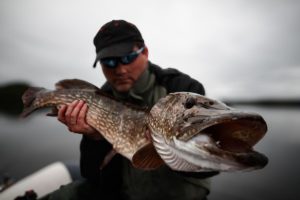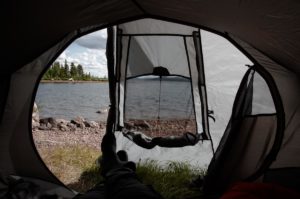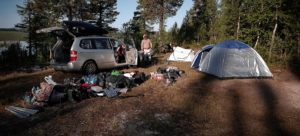A trip to Scandinavia for a fishing expedition is a dream come true for many. The beautiful landscapes, clean waters, and abundance of fish make Sweden and Finland increasingly popular destinations for fishing adventures. However, to ensure a successful trip, proper logistical preparation is essential. How to get there, where to stay, and what to bring? Here’s a comprehensive guide.
Transportation
The choice of transportation depends on various factors such as budget, comfort, the amount of gear, and travel preferences. This decision affects not only the travel time but also the ability to transport fishing and camping equipment. Each option has its pros and cons, detailed below are the most popular ways to get to Sweden and Finland.
Airplane – Flights to Scandinavia
Flying is the fastest way to get to Scandinavia. Airlines offer many connections to major cities in Sweden and Finland, such as Stockholm, Gothenburg, Helsinki, and Turku. Flights from Warsaw to Stockholm take just 1.5 hours, making it possible to be at the lakeside with a fishing rod in hand the same day.
When choosing to fly, pay attention to the airline’s policy on transporting fishing gear. Some airlines offer special baggage packages for anglers, which can significantly simplify the journey. Also, consider weight restrictions—packing needs to be done thoughtfully. If planning to bring large equipment like fishing rods, kayaks, or belly boats, it’s best to consult with the airline in advance to ensure it’s possible.
Flying is an excellent option if you have reserved a cottage with a boat and can limit yourself to a small amount of gear. Renting a car on-site is usually necessary if traveling independently and not using a travel agency, which often offers airport pickup. Public transportation is generally inefficient, though in some cases, taking a train might be a good solution.
Car and Ferry – Traveling with Your Vehicle from Poland
For trips to the northern edges of Europe, traveling by car is often preferred. This method offers undeniable advantages, such as complete freedom in planning the route and the ability to take more gear without worrying about baggage limits. The road route from Poland to Sweden or Finland goes through Germany and Denmark or via the eastern side through the Baltic states and Russia. The most convenient way, however, is to take a direct ferry from Poland, e.g., from the Tri-City to Karlskrona or Nynäshamn. The ferry from Tallinn to Helsinki is an excellent option when traveling to Finland and often, when going to Swedish Lapland, it shortens the total travel time with a similar distance to cover by car.
Traveling by car also allows easier customization of the trip to your needs and preferences. You can stop along the way, visit interesting places, and fully enjoy the journey. Driving through the picturesque landscapes of Scandinavia is an attraction in itself. In the north, you can encounter not only road signs warning about moose but also reindeer herds that sometimes occupy the entire roadway, halting traffic. In such cases, the only option is to wait until they move back into the forest.
If planning a trip with your boat or inflatable, the car becomes practically the only option. It’s worth exploring different routes, including crossing the bridge through Denmark or various ferry options. For long routes north, consider an overnight stop, but when traveling in a group, it’s possible to travel without sleep breaks, changing drivers every few hours.
When deciding on the route option, it’s best to calculate all available options considering the total time spent on the road (including time in the car and on the ferry), costs (fuel and ferry costs, and potential overnight stays if considered). Depending on individual priorities, different options may turn out better—not always the one you would intuitively choose.
How to Organize the Route?
Determining logistics and packing for a fishing trip to Scandinavia is a crucial preparation stage. If planning to fish from the shore or having a reserved boat waiting, packing is relatively simple. In such a situation, take primarily fishing gear, clothing suitable for various weather conditions, and food. However, it’s essential to check what’s available on-site—there have been cases where the boat was there, but there was no mention of a motor or echo sounder. Assuming only personal equipment, usually, there is plenty of space in the car, and depending on the overall trip configuration, one car is often sufficient for four people.
If planning to take your inflatable or boat, the situation becomes more complicated. An inflatable is relatively easy to transport and can be packed in the car’s trunk. However, it takes up a lot of space, especially if also taking a motor. If additionally planning wild camping and taking camping gear, space becomes an issue. Transporting everything in the car usually means packing it to the ceiling (of course, folding the rear seats) and still limiting the gear to a minimum. Alternatively, especially when traveling in a larger group, consider an additional cargo trailer. Often, traveling further north, we chose to travel with four people (two teams) in one car, which allowed changing drivers and increased travel comfort. In such cases, a trailer is essential, packing almost everything: all equipment, including two inflatables and two motors, tents, mattresses, fishing gear, etc. This organization method allows taking more equipment without overloading the car and ensuring comfort during the long journey.
Traveling with your boat provides ample space for gear, but usually means having only two drivers available, which is challenging for long routes, for example, to Lapland. In such cases, planning the route well and regular driver changes (usually mandatory every 2 hours on our trips) is crucial to avoid excessive fatigue.
Accommodation
Choosing the right place to stay is essential for comfort and success during a fishing trip. Scandinavia offers a variety of accommodation options, from comfortable holiday cottages to more rugged camping conditions.
Holiday Cottages
Holiday cottages are a popular choice among anglers. They offer comfortable conditions, proximity to fishing spots, and the ability to cook your meals. Renting a cottage near a lake or river provides convenience and saves time that can be spent fishing instead of commuting. Cottages are often equipped with essential amenities like a kitchen, bathroom, and sometimes a sauna, adding charm to the stay. Booking a cottage, either directly or through a travel agency, guarantees convenience.
If planning to fish on a large river or lake, the boat’s matter is crucial. If not bringing your own and renting on-site, make sure the equipment meets your expectations. The boat’s size, type (displacement or planing), engine size (popular small boats with 4HP or 6HP engines might not cover long distances on water), and additional equipment like an echo sounder or trolling motor are significant. Analyze the fishing spot’s character and your fishing style to avoid disappointment if the great lake doesn’t satisfy you due to unsuitable equipment.
Where to Find Accommodation?
When going on an organized trip, everything is usually provided. This is the most convenient but means choosing from available fishing spots. If wanting to go to a different water body or organize the trip independently—e.g., visiting several fishing spots during one trip—you need to find accommodation yourself. Websites like www.booking.com or www.airbnb.com are well-known and a good starting point for searches. However, in Scandinavia, a significant part of potential rental homes isn’t available on these popular services. It’s worth checking other, more local ones. Some reliable sites we’ve used include: www.stugknuten.com/defaulteng.asp, https://www.dancenter.co.uk/, https://www.vrbo.com/pl-pl, and https://www.interhome.pl/.
When searching for a cottage with a boat, inquire about it—though not always, in many cases, the property owner may have a boat available or help organize one on-site, though this shouldn’t be expected in every case.
Camping and Tents – Wild Camping
For those seeking closer contact with nature, camping and wild camping are ideal. This is also our favorite way of organizing our trips. Scandinavia, thanks to its “Allemansrätten” (right of public access), allows camping almost anywhere, with some restrictions on private lands and nature reserves.
A cool but not cold evening, crackling campfire, and a shared meal prepared on an open fire after a day of fishing—these are moments often remembered… Wild camping in a tent offers unparalleled freedom and the chance to experience a real adventure.
However, appropriate preparation is crucial—a camping stove, a warm sleeping bag, clothes, and a solid tent are essential—not always the conditions are as we imagined. When wild camping, also take care to minimize environmental impact. Scandinavians value their nature highly, so follow the leave-no-trace principles—don’t leave trash, avoid damaging vegetation, and keep noise to a minimum. It’s also good to know local regulations regarding camping and fires to avoid unpleasant surprises.
Choosing this accommodation option presents additional challenges: selecting a camp spot and a boat launching site—this travel variant means relying on your “floating device,” unless opting for shore fishing, which is an alternative mainly by rivers.
Here we return to Google Maps, analyzing satellite images in detail—usually, all potential launching spots can be identified this way. However, don’t limit yourself to one spot, as maps don’t show everything. Often on-site, it turns out that access to the lake at the chosen point is blocked by a locked gate—such situations have increasingly occurred even in the far north in recent years. Therefore, identify at least several alternatives to check when reaching the lake.
Secondly, similarly select a camp spot. Ideally, it should be close to the slipway—this provides the greatest comfort. Next, choose places accessible by car and boat launched elsewhere. Finally, choose places only accessible by boat—e.g., on an island. Such camping has extra charm but creates additional operational problems related to transporting all equipment and possibly returning to the car for extra items.
Selecting a camp spot besides the popular Google Maps, also use the Google Earth Pro application, which can be installed on your computer for free. It allows viewing additional satellite images over time, usually taken at different times of the year and under various weather conditions (and at different water levels in the reservoir).
As with choosing a boat slip location, all assumptions will be verified on-site. Access to the chosen place may be locked, and a beautiful lakeside meadow might be a swamp or rocky ground covered with moss. In many cases, we chose small forest roundabouts near the water, remnants of heavy equipment turning areas used for logging in previous years. Usually, these are well-hardened, flat, and easily accessible places, providing comfort while being close to nature.
What to Bring from Poland?
Good preparation for a fishing trip is key to success. It’s important to bring everything that might be needed, both for fishing and daily life at the camp. Remember, Scandinavian weather can be capricious—within one day, you can experience scorching sun and heavy rain, and within a few days, thirty-degree heat can drop to barely above freezing, especially if going further north. Be prepared for all possibilities when traveling to Scandinavia.
Fishing Gear
The foundation is, of course, fishing gear. Rods, reels, lures—all should be well-chosen and checked before the trip. When fishing from a boat, an echo sounder with GPS is essential, ideally with pre-loaded bathymetric maps to help find the best fishing spots.
What sets to take? We’ll delve deeper into fishing-specific issues in future parts of this series, but generally speaking—you need to bring everything. Often, at the end, you fish with 3-4 lures throughout the trip, but the key is identifying what those lures are. Though Swedish and Finnish waters are often very fish-rich, it doesn’t mean fish bite always and everywhere. We know many cases where anglers focused on a specific fishing style suffered bitter failures, unable to adapt to the fishing conditions.
I remember one of the first trips to Sweden many years ago on Lake Hjalmaren, when spring pikes, caught a few days earlier by a friendly team in meter-deep water, literally vanished, and all indicated spots were empty. A sudden weather change, with strong winds, rain, and a pressure drop, caused the pikes to go very deep—we found them at 12-16 meters but couldn’t provoke bites. Occasionally, we noted delicate nibbles on large soft baits. The trip’s savior turned out to be zanders, which bit wonderfully on several-meter-deep rocky flats, both traditionally on soft baits and jigs, and small crankbaits in trolling.
This shows why and how to prepare equipment-wise for a trip—from jerkbaits, soft baits, and spoons for shallow water fishing, through heavy “meatballs,” all trolling gear, and vertical fishing equipment, as well as alternative toys for other fish species. Most of the gear may remain unpacked, but if the fish don’t bite as hoped, it’s good to have options to experiment with.
Such details as lines, additional accessories, landing net, hooks, line scissors, anti-pike leaders, and a whole lot of small items don’t need reminding—but remember, in remote areas, there might not be any store to replenish missing gear.
Camping Equipment and Other Essentials
Camping gear is indispensable at the camp. A solid tent, sleeping bags, sleeping pad or mattress, and a camping stove are fundamental. Also useful are tools for preparing meals, such as basic pots, pans, and cutlery. Bring a food supply, including dry high-calorie products like rice, pasta, and groats. Canned goods and instant soups can be an emergency option, but it’s better to supplement the diet with freshly caught fish.
Also, remember to have a supply of clean water or water filters to use lake water.
Every angler going on such a trip likely has their tried-and-true methods, and camping or broadly bushcraft is a vast topic described by experts. Therefore, in our fishing trip texts, I’ll give only a few tips from our trip experience:
Scandinavian weather can be very unpredictable, so be prepared for all conditions—ready for heat but more so for several days of rain at a few degrees Celsius. Good rain gear is fundamental. For me, in “light rain,” it’s a comfortable set (jacket and pants) with a membrane, including a cap and Goretex gloves. For real downpours lasting longer—waders and a storm jacket. Additionally, staying warm is crucial—several variants of fleece and down clothing are a must-have on such trips. In a budget version, foam rubber boots and rubberized rain sets, which work great in the field and are really robust, can be a cheap alternative.
Cracked lips from wind and sun and cut hands from pike are standard and hard to avoid, so hand cream and vitamin ointment for lips are real reliefs on such trips.
Scandinavia is largely a huge rocky area—tent stakes usually bend easily—think about titanium stakes or alternatively—long, strong steel nails that can be driven into the ground.
Consider safety and comfort during long days on the water. A life jacket is not only a safety element but also psychological comfort. Also, have a first aid kit with basic dressings, disinfectants, and medicines in case of minor injuries or ailments. Additionally, take spare batteries, power banks, and appropriate flashlights and camping lights.
Food Storage
While wild camping, food storage becomes a key challenge. If access to a refrigerator is limited, use natural cooling methods. Often, the lake becomes our cooler. Products requiring freshness, like packaged meat, can be stored at the lake’s bottom in an old-fashioned wire fish basket weighted with stones. Tie it to a line with the other end attached to a buoy, such as a five-liter water bottle. Water at the bottom, a few meters deep, is around 4 degrees Celsius, allowing food storage for at least a few days even in the hottest weather.
Summary
The logistics of a fishing trip to Scandinavia might seem complicated, but with proper preparation, it becomes part of the adventure. Choosing transportation, accommodation, and assembling the necessary gear are key elements affecting the trip’s success and comfort. Good planning allows enjoying every moment spent fishing and exploring the charms of Scandinavian nature.
Each trip is not only a challenge but also unforgettable memories that last long. Whether planning to travel by plane, car, or with a travel agency, the most important is to enjoy every moment among beautiful landscapes and fish-rich waters of Scandinavia. In future articles of our series, we will discuss in detail the necessary equipment, on-site organization, and practical tips to help maximize fishing opportunities in Scandinavia. We invite you to read!













